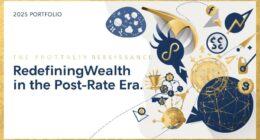Why this moment demands a strategy refresh
As 2025 moves into its final quarter, investors are confronting a landscape that demands recalibration rather than simply staying the course. The global economy continues to grow, but at a muted pace: the World Bank projects growth in Europe & Central Asia at only ~2.4 % this year, below its 2010-19 average. World Bank At the same time, the macro backdrop is more complex: interest rates are structurally higher than the ultra-easy era, trade and geopolitical risks are elevated, and thematic shifts like AI, sustainability and regionalisation are gaining traction. Morgan Stanley+1
For many investors, the old playbook — overweight U.S. large caps, long-term bonds as ballast, broad diversification without much tilting — is under pressure. Major asset managers such as the BlackRock Investment Institute now emphasise that “investing in the here and now” matters more than ever, citing tighter yields and more defined macro constraints. BlackRock
In short: this is a pivot moment. The opportunity lies not in chasing yesterday’s winners, but in repositioning portfolios for the next phase. That means revisiting geography, asset-type, valuations, thematic exposures and risk frameworks.
Key themes to anchor your portfolio
Globally diversified equity exposure beyond the U.S.
For much of the last decade, U.S. equities dominated the global investment narrative, buoyed by scale, innovation and favourable policy. In 2025, however, there’s growing recognition that value may lie beyond U.S. borders. For instance, the MSCI notes that U.S. public assets “lost their edge in the first half of 2025,” with allocators pivoting toward non-U.S. markets amid changing macro signals. MSCI
Strategy implications: Consider increasing exposure to developed ex-US markets (Europe, Japan, Australia) and selectively to emerging markets (Asia, Latin America) where valuations, currencies and growth expectations may align favourably. The key is selectivity – not blanket global exposure but managing regional and sector risk, currency risk and political/regulatory risk.
At the same time, keep U.S. equity exposure as a core holding—the depth and liquidity of U.S. markets remain unmatched—but avoid over-concentration.
Real assets, infrastructure and inflation-linked plays
With bond yields elevated and growth uncertain, real assets and infrastructure are increasingly getting attention. According to commentary, infrastructure investing is “emerging as a resilient and attractive option amid ongoing global market volatility” thanks to inflation linkage, stable cash flows and long-duration returns. MoneyWeek
Within this bucket you might consider: listed infrastructure ETFs, renewable energy assets, data-centre/logistics infrastructure, and private real-asset funds (if accessible). These can serve as portfolio ballast, diversify away from pure equity/bond risk, and offer exposure to long-term themes like decarbonisation and digitalisation.
Private markets & alternatives as asymmetry sources
Public markets, particularly the largest growth stocks, are richly valued and increasingly exposed to regulatory/valuation risks. By contrast, private markets remain under-allocated in many institutional portfolios and may offer diversification and return enhancement. The McKinsey & Company 2025 Global Private Markets Report finds that LPs intend to increase allocations to private markets even amid uncertainty. McKinsey & Company
Practical take-aways: If you’re an accredited investor or using access vehicles, explore private equity, infrastructure, real-asset secondaries or GP stakes. If you’re a retail investor, consider secondary funds, listed alternative vehicles or thematic funds that provide exposure to private-market style returns with higher liquidity.
Thematic tilts: AI & digitalisation, energy transition, longevity
Investment themes are no longer optional extras—they’re becoming central to portfolio construction. As highlighted by Morgan Stanley Research, key themes for 2025 include de-globalisation (or regionalised globalisation), the future of energy, longevity investments, and AI/digital evolution. Morgan Stanley+1
For instance:
-
AI & digital infrastructure: companies enabling the next wave of enterprise productivity.
-
Energy transition & green infrastructure: utilities, grid modernisation, renewables.
-
Longevity & healthcare innovation: ageing demographics and biotech breakthroughs.
Again: Theme exposure should be measured. Use it as a tilt rather than the entire foundation.
Risks and guardrails to keep front of mind
Valuation risk remains elevated
With many equity markets at extended valuations and bond yields no longer negligible, the margin for error is smaller. Several strategists are flagging “momentum risk” and cautioning that not all thematic exposures will succeed. BlackRock+1
Therefore: Maintain strong discipline on valuations, remain diversified, avoid chasing price spikes.
Rate and liquidity risk
Higher yields reduce the attractiveness of long-duration assets and increase the burden of leverage. Any surprise from inflation or central-bank policy can upset fixed income and equity correlations. Given this, traditional bond/equity diversification may underperform. Portfolio construction needs to account for changing dynamics.
Geopolitical and policy risk
Trade tensions, regional conflicts, regulation shifts (especially in technology and climate) are increasingly relevant. For emerging markets and thematic exposures, political/regulatory execution risk can matter as much as economic fundamentals. For example, macro-tailwinds for emerging markets exist, but currency, governance and flow risks remain. MSCI+1
Liquidity & access constraints
Moving into alternatives, private markets or real assets brings liquidity trade-offs. If you’re allocating to these, ensure time-horizon alignment, clear access terms, and buffer for potential illiquidity.
Practical portfolio moves for this phase
-
Review your region weights:
-
Are you overly concentrated in the U.S.?
-
Could you meaningfully increase developed ex-U.S. or emerging markets exposure (e.g., via ETFs, funds) while managing risk?
-
-
Real-asset / infrastructure allocation:
-
Consider modest allocation (for example 5-15% depending on risk profile) to infrastructure, renewable energy, data-centre or logistics real assets.
-
Use liquid listed vehicles if direct access is too costly or illiquid.
-
-
Thematic tilts, not bets:
-
Add thematic exposures (AI, energy transition, longevity) but limit them to say 10-20% of equity allocation so you’re not betting the farm.
-
Maintain core holdings (e.g., broad global equity, US major indices) for stability.
-
-
Maintain defensive ballast:
-
Though traditional bonds may underperform, consider short-duration fixed income, inflation-linked bonds, or global bond diversification as portfolio stabilisers.
-
Cash or short-term instruments may serve as optionality vehicles in a volatile environment.
-
-
Rebalance and monitor valuations:
-
With themes and regional tilts, it’s easy to drift. Set rebalance thresholds (e.g., 5-10% deviation) and monitor.
-
Assess thematic holdings for execution risk and revisit assumptions periodically.
-
Final thoughts: repositioning for what’s next
The takeaway for an investor in late 2025 is clear: the best path forward is not simply more of the same—nor is it chasing the hottest theme blindly—but rather a thoughtful pivot. That pivot involves adapting to elevated yield regimes, regional shifts, thematic and structural change, and liquidity constraints.
Your aim should be to blend core holdings (broad global equity, quality bonds/defensive assets) with strategic tilts (geographic non-US exposure, real assets, alternatives, thematic growth). At the same time, stay focused on risk: valuation discipline, liquidity readiness, and macro regime flexibility matter more than ever.
As the global economy transitions—from low rates and ultra-liquidity into a higher-rate, more structurally volatile era—the investor who repositions thoughtfully, rather than reacts hastily, stands the best chance of capturing returns while controlling risk.
In short: 2025 is not a year to stay idle. It’s a year to re-align.









